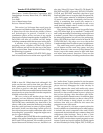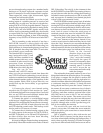not match what the DSP-A1 could do at home (at least
in my room) with the CD version is a credit to the
Yamaha DSP technology.
Of course, it is also possible that the master tapes
were indeed configured for future surround-sound
productions, and in that case the Yamaha DSP
ambiance simulation processing looks even more
impressive.
I do have to make one point. Yes, with multi-
channel materials that use the surround channels only
for simulating hall ambiance, I believe that good,
home-based DSP ambiance-generating technologies
(this would also include DPL II and DTS Neo:6
ambiance-extraction technologies) in combination with
good two-channel source material will be as successful
at simulating a live-music space as good SACD and
DVD-A surround source materials. This certainly
would apply to most classical material and a lot of
acoustic jazz, too. However, with recorded pop music
all bets are off.
Most pop music is not recorded with the intention
being to simulate a live performance in a hall, club,
auditorium, etc. Rather, they are typically engineered
to be ends in themselves. This means that the engineers
often place performers (vocalists, drums, horns, and
even pianos) in all of the channels, essentially putting
the listener into the middle of a musical soundfield.
With that kind of material, SACD and DVD-A
surround recordings (as well as music recorded with
DD or DTS technology) have a major advantage over
synthesized ambiance from two-channel inputs.
There are classical-music exceptions, of course.
Think of some of the stuff Berlioz did, as well as some
church-choral music, and of course something like the
1812 Overture, would probably sound really
impressive with the cannons coming from all around
you. And if the listener also wants audience sounds
(applause, chair squeaks, coughing, etc.) around him
when listening to classical performances recorded live
then obviously surround-sound recordings have an
edge. Still, for most acoustic-music recordings that are
to simulate live performances, DSP ambiance
simulation working with good two-channel inputs will
almost always sound as realistic as the surround-
sound versions.
Now, this leaves only one other item to deal with
regarding the supposed superiority of SACD
compared to the compact disc: per-channel sound quality.
Well, if it was there I did not hear it. The results were
similar to what I experienced with DVD-A materials.
The extended bandwidth and lower noise floor of the
SACD simply did not mean anything as best I could
tell. The CD was more than quiet enough (the major
background noise involved non-obnoxious hall
artifacts and possibly very low-level microphone noise
and not the digital technology) and the extended
bandwidth above the top audible octave provided by
SACD technology remains, in my opinion, laughable
overkill.
Of course, this only involves one comparison. It is
possible that other contests would lean in favor of the
SACD versions. However, I have pointed out before
that this particular CD is one of the very best sounding
concert-hall recordings I have ever encountered (I often
use it when doing my speaker testing A/B
comparisons), as well as one of the best baroque-
ensemble performances that you will ever hear. I think
that the technological excellence of any CD is
important in a face off of this kind, because it reduces
the chances that it would sound worse than an SACD
because of poor mastering done with the former. If
SACD is to better what CD technology can offer it has
to be able to surpass the very best example of that
technology.
In this case, the only way the SACD surpassed
the two-channel CD version involved the additional
channels. However, once the Yamaha DSP-A1’s
ambiance-simulation circuits were called into play to
assist the CD by simulating additional channels the
contest was over. The processor/CD collaboration
delivered the superior goods. The good news about
this is that this kind of assistance can be applied to
every CD already in one’s collection if one is willing
to spring for a good DSP device.
I did manage to listen to a number of other SACD
recordings, and those will be reviewed in my Scoping
Software column, possibly in this issue. I also listened
to a number of DVD-A releases on the player, most of
them previously reviewed by me after being played
on the Onkyo DV-S939 installed in my main system.
The sound was notably good if the discs were recorded
well and often a major flop if they were not. (Flop
status is not uncommon at all with quite a few DVD-
A and SACD releases, due mainly to them being
remastered from rather old source materials.)
One excellently recorded DVD-A release, the
Swingin’ for the Fences jazz item noted previously, has
a genuine center channel feed and it actually sounded
terrific even with the NHT VS1.2 center speaker in my
middle system mounted fairly high up on a big-screen
TV monitor. (Fifteen inches higher up than the vertical
source center of either of my Cantata main-channel
systems.) The centered up trumpet section actually
sounded like it was at the back of the ensemble, located
fairly high up on risers.
However, speaker-location issues aside, SACD
and DVD-A sound quality will have far, far more to
do with the recording and mastering techniques
involved (particularly involving microphone quality
and placement, as well as mixing judgments) than with
the disc technologies themselves. And that’s a fact.
OK, so what do I think of this Yamaha DVD-
S1500 player. Well, I think it is a really nice unit. I went
over some of the problematic characteristics










